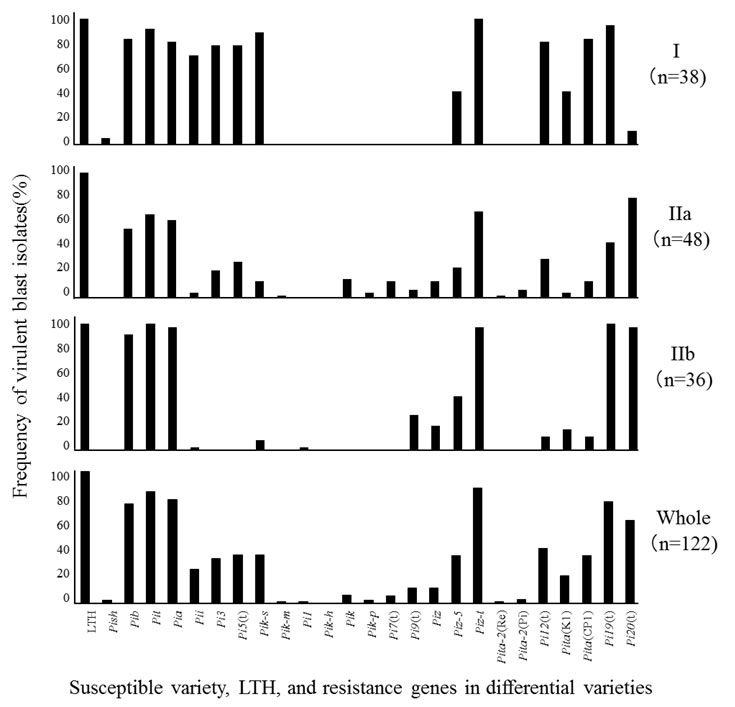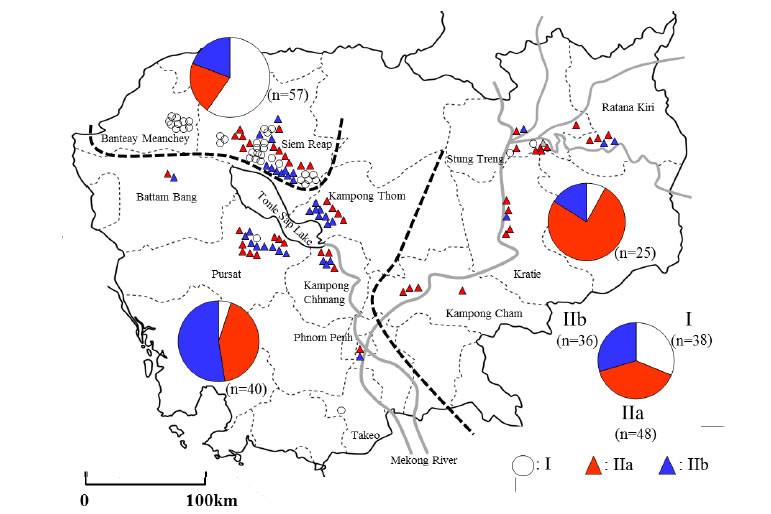Pathogenicity of Rice Blast (Pyricularia oryzae Cavara) Isolates from Cambodia and its geographical distribution
Description
The evaluation of a total of 122 blast (Pyricularia oryzae Cavara) isolates collected from the Tonle Sap and Mekong river regions of Cambodia revealed wide variation.
Using a new designation system, the blast isolates were categorized into 92 races based on the reaction patterns of rice differential varieties (DVs) harboring 23 resistance genes and of 1 susceptible cultivar, Lijiangxintuanheigu (LTH).
Cluster analysis was used to classify the blast isolates into 3 groups — I, IIa, and IIb — using data from these reaction patterns of the DVs and LTH (Fig.1). We used the classifications established under the new designation system, alongside cluster analysis and the geographical distribution of blast isolates, to investigate the diversity and differentiation of blast races in the Tonle Sap and Mekong river regions.
The distributions of the blast races differed between the 2 regions, although blast isolates of group IIa were distributed commonly in both regions and groups I and IIb occurred at higher frequencies in the Tonle Sap region rather than the Mekong region. The blast isolates in groups I and IIb were also less diverse than those in group IIa. Accordingly, Group II blast isolates overall were distributed in both regions with high diversity, but some modified blast isolates were additionally distributed in the Tonle Sap region (Fig.2).
Figure, table
-
Fig. 1. Frequency of virulent blast isolates from Cambodia against differential varieties.
Blast isolates from Cambodia were classified into three groups -- I, IIa, and IIb -- by cluster analysis based on the reaction pattern data of differential varieties harboring 23 resistance genes and of 1 susceptible cultivar, Lijiangxintuanheigu (LTH). -
Fig. 2. Distribution of blast isolates, classified into three groups--I , IIa, and IIb--in Cambodia.
Blast isolates of group I was distributed at a high frequency in Siem Reap. In the Mekong River region, group IIa was found at a high frequency, whereas groups I and IIb were at low frequencies. In the Tonle Sap region, the frequency of groups IIa and IIb were similarly high. High diversity group IIa probably comprises the basic population of blast races in Cambodia and that groups I and IIb were modified from IIa. These unique distributions of blast races among the 3 regions might occur and be attributable to differences in genotypes of blast resistance genes in the cultivated rice varieties.
- Affiliation
-
Japan International Research Center for Agricultural Sciences Biological Resources and Post-harvest Division
Japan International Research Center for Agricultural Sciences Tropical Agriculture Research Front
- Classification
-
Administration B
- Research project
- Program name
- Term of research
-
FY 2013 (FY 2011-FY 2015)
- Responsible researcher
-
Fukuta Yoshimichi ( Tropical Agriculture Research Front )
Koga Ikumi ( Biological Resources and Post-harvest Division )
Ung T. ( Cambodian Agricultural Research and Development Institute )
Sathya K. ( Cambodian Agricultural Research and Development Institute )
Tanaka Akiko ( Tottori University )
Koide Yohei ( Research Fellow of the Japan Society for the Promotion of Science )
KAKEN Researcher No.: 70712008Kobayashi Nobuya ( Institute of Crop Science, NARO )
KAKEN Researcher No.: 70252799Yanada H. ( Cambodian Agricultural Research and Development Institute )
Hayashi Nagao ( National Institute of Agrobiological Sciences )
KAKEN Researcher No.: 90391557 - ほか
- Publication, etc.
-
https://doi.org/DOI: 10.6090/jarq.48.155
Fukuta, Y. et al. (2014) JARQ, 48:155 - 166
Pathogenicity of Rice Blast (Pyricularia oryzae Cavara) Isolates from Cambodia
- Japanese PDF
-
2013_B05_A3_ja.pdf186.23 KB
2013_B05_A4_ja.pdf509.11 KB
- English PDF
-
2013_B05_A3_en.pdf181.69 KB
2013_B05_A4_en.pdf230.56 KB
- Poster PDF
-
2013_B05_poster.pdf410.53 KB


